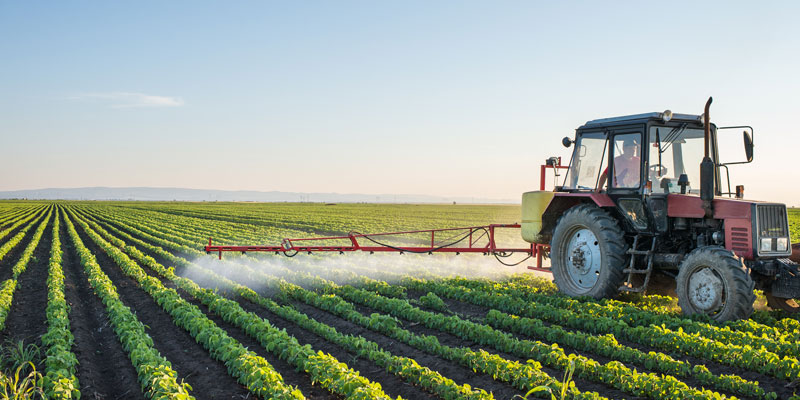It is common to find residual pesticides in the food products we buy – especially in staples such as fruits and vegetables, grains, and nuts/seeds. Generally, residue from pesticides can stay on foods and at times be even absorbed. The amounts are at most often at safe levels by the time products reach consumers, as over time they break down and very little residue is left. However, there are conditions where pesticides can pose a risk to human health for instance if they are improperly used by a food producer, or inadvertently make their way, indirectly or directly into crops through soil, water, and air and thereby result in harmful pesticide levels. This is where regulations and laboratory testing play an important role to safeguard consumers.
To be healthy, we all need to eat a variety of foods. Pesticides play an important role in making sure enough food for everyone reaches the table. Pesticides are used to protect crops and are sprayed onto them during the growing period. They help to control pests, weeds, and fungal diseases to protect our food supply through all stages, from the growing period, harvest, storage, manufacturing, production and through to distribution. It is one thing to deal with the products produced locally; however, globalization has increased the need for more stringent regulations around pesticides testing. For example, in 2007, the U.S. Food and Drug Administration warned the public not to eat fresh ginger imported from China as it was tainted with aldicarb. Aldicarb is toxic pesticide where ingesting even a small amount can cause severe symptoms such as headache, sweating, nausea, diarrhea, loss of coordination and death.
As well, in recent years there continues to be an increase in the development and usage of higher specificity pesticides thereby adding further challenges to pesticide monitoring, regulatory adherence, and testing. These pesticides target specific types of insects (Insecticides), invasive plants such as weeds and herbs (herbicides), diseases (fungicides), and rodents (rodenticides).
Regulations on pesticide usage and analytical laboratory testing are two ways to stay a step ahead in safeguarding consumers from unsafe levels of residual pesticides in food products.
Regulations on Residual Pesticides
In Canada, the Pest Management Regulatory Agency (PMRA) is responsible for regulating pesticides usage. The agency sets Maximum Residue Limits (MRL) using a science-based approach to establish acceptable levels of pesticide residue. According to section B.15.002 (1) of the Food and Drug Regulations (FDR), in the absence of a specific MRL, residues of a pesticide or other agricultural chemical must not exceed the general MRL of 0.1 ppm. MRLs are regulated under the Pest Control Products Act and apply to both domestically produced foods and imported foods, for which samples are inspected at the point of entry into Canada.
In collaboration with other global entities and experts, the agency conducts rigorous scientific and risk evaluations on pesticides prior to being made available on the market. According to Health Canada, “Canadian MRLs are set for each pesticide and crop combination, for an approved pesticide use” on several factors:
- Are legally established as the highest amount of allowable residue
- Are set at levels far below the amount of pesticide residue that could cause health concerns
- Consideration of the entire population including infants, children, and pregnant women
- Are set for all foods sold in Canada, whether produced locally or imported
- Apply to fruits, vegetables, meat, dairy products, grains, and some processed foods
Furthermore, the Canadian Food Inspection Agency (CFIA) as a part of their routine monitoring programs performs analytical testing to ensure that foods available on the Canadian market are safe for consumers. The surveillance testing programs help CFIA and other regulatory bodies to generate baseline data on the level of pesticide residue and metal levels in foods.
Risk Mitigation through analytical testing
Pesticides are categorized as chemical hazards under the Hazard Analysis and Critical Control Point (HAACP) system. The category also includes antibiotics, food additives such as preservatives, and other chemical contaminants food may encounter such oil, grease and cleaning agents used for machinery and equipment.
Single and multi-residue screening can help detect and quantify many classes of insecticides, fungicides, and herbicides. Single residue testing is often used to verify the absence and the level of a specific pesticide and testing is often quick. However, screening for one pesticide means possibly missing others thereby multi-residue screening is comprehensive and the preferred approach.
There is no standard to how labs test for pesticides and approaches can differ from lab to lab. At CAL we use LC-MS/MS and GC-MS/MS which are widely used for pesticide residue analysis. Both approaches provide a high level of sensitivity and precision and choice of technique depends on the pesticides in question as some are detected better by GC-MS/MS and others by LC-MS/MS.
Our expert teams have many years’ experience with analytical testing across numerous product types as well a long successful history with developing and validating methods for new compounds. Our ISO/IEC 17025:2017 accreditation provides further assurance through continuous quality and accuracy monitoring both internally and for external vetting of our supply chain partners such as vendors and other service providers.
We test the following products for pesticides:
- Processed Foods Snacks and Confectionary
- Beverages (alcoholic, non-alcoholic, juices, tea, coffee)
- Ingredients, Spices, Herbs, Food Additives, and Fats and Oil Products
- Dry Goods (Cereals, Grains, Pulses, Sugar)
Timeliness is everything when it comes to testing food products and especially more so critical for fresh foods. Our rapid analytical turnaround times provide the information you need to make accurate decisions about your food product safety. For more information about pesticides testing, contact our experts.







